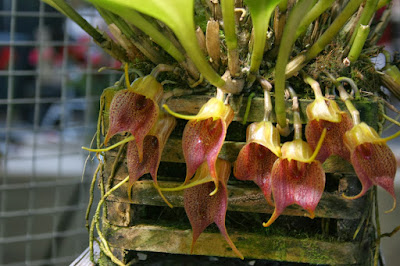Masdevallia angulata is native to Colombia and Ecuador. This species is relatively common and locally abundant in the regions of the mountain rainforest in the provinces of Pichincha, Imbabura and Manabí in the northwest of Ecuador...
Masdevallia angulata also called as The Sharp Angle Masdevallia, Byrsella angulata, Masdevallia burfordiensis, is a species of the genus Masdevallia. This species was described by Heinrich Gustav Reichenbach in 1878. The species epithet is from Latin and means with angles.
IDENTIFY MASDEVALLIA ANGULATA
Masdevallia angulata is native to Colombia and Ecuador. This species is relatively common and locally abundant in the regions of the mountain rainforest in the provinces of Pichincha, Imbabura and Manabí in the northwest of Ecuador. In addition, these plants have been relatively recently discovered in neighboring southern Colombia, above the Ricaurte River in the Narino department. The species usually occurs at an altitude of 1500-2100 m, but in the province of Manabí in Ecuador it was found at lower heights - about 600 m. It seems that these plants feel just as well, growing as epiphytes in the mossy trees in the mountain rainforest, and in humus land in shady places, or even on the side of the roads. Occasionally it is also found on rocks.
It is a miniature to small sized, cool growing terrestrial or lithophyte, which reaching a size of 11-24 cm, with clump-forming, stout, erect, purplish ramicauls enveloped basally by 2 to 3 loose tubular sheaths carrying a single, apical, erect, coriaceous, oblong-obovate, obtuse to rounded, 8-18 cm long leaf that is cuneate into the stout channeled petiole.
The Sharp Angle Masdevallia blooms in the fall through late winter on a slender, suberect to descending, 2.5 to 6 cm long, single flowered inflorescence arising from low on the ramicaul with a loose, tubular, floral bract carrying a large, fleshy, foul-smelling, long-lasting, color-variable flower held way below the leaf. The flowers are 5 cm in diameter. The flowers of this species are variable in color, foul-smelling (“rotten meat” would be a good description), and very long lasting (months). The flowers can also exude droplets of a sugary substance, which in combination with the distinctive odor must play a role in the attraction of the pollinator of this species. The upper petal of the outer perianth is colored from yellow to orange and dotted, which makes it appear red or purple. It is connected to the lateral petals of the outer skin from the base, forming a broad, cylindrical tube. The triangular, free apical portion shrinks and goes into a slender, raised petiole. The inner surface of the lateral petals is densely covered with dark red-violet spots. The outer petals of the perianth are connected to each other at the base to form a plate. Triangular, free apical parts go into thin tails. The creamy-colored inner petals have 3 purple veins. The ruff is densely covered with scattered, red-violet dots, and the white prong has purple edges.
MASDEVALLIA ANGULATA CARE AND CULTURE
Cultural information should only be used as a guide, and should be to be adapted to suit you. Your physical location; where you grow your plants, how much time you have to devote to their care, and many other factors, will need to be taken into account. Only then can you decide on the cultural methods that best suit you and your plants.
Light:
Masdevallia angulata needs a light level of 10000-18000 lux. The light should be filtered and dispersed, and the plants should not be exposed to direct sunlight. Strong air movement should be ensured all the time. This species shows a much higher tolerance in terms of light requirements than most plants belonging to this type.
Temperature:
It is a plant with moderate thermal requirements. Similar throughout the year - the average temperatures on 24-27 ° C, average night temperatures 12-13 ° C, with an amplitude of daily variations of 11-16 ° C.
Humidity:
The Sharp Angle Masdevallia needs the humidity of 75-80% for most of the year. In the period of 2-3 winter months, it drops to 60-65%.
Substrate, growing media and repotting:
Masdevallia angulata grow well mounted on pieces of tree ferns or cork, but in the summer it requires high humidity and daily watering. In the case of such attached plants, during the dry and hot periods it may be necessary to water several times a day.
They can also be grow in pots. In this case, you can use a substrate quickly draining excess water, which, however, contains substances that retain a certain amount - such as chopped sphagnum moss or perlite. Wood charcoal is also often added to ensure the air permeability of the substrate and protection against acidification. It is recommend repotting the plants every year.
Watering:
In the period from spring to late autumn rainfall is moderate to heavy. In winter, there are slightly drier conditions. For most of the year, the cultivated plants should be kept in an even humidity, while in late autumn watering should be somewhat limited.
Fertilizer:
If the plants grow in sphagnum moss, tree fern fibers or osmunda fern roots, they should be fertilized every 3-4 weeks with 1/4-1/2 of the recommended dose of orchid fertilizer during the period of strong growth. If grown in a bed of pine bark, fertilization can be applied every 1-2 weeks.
At the beginning of the year, when the plants grow actively, instead of fertilizers with equal proportions NPK, you can use fertilizers with high nitrogen content. In contrast, in late summer and autumn, use high phosphorus fertilizers to stimulate plants to flower.
Rest period:
In winter, watering for Masdevallia angulata during this period should be reduced to some extent, but the plants must never be allowed to dry out completely. Fertilization should be limited or should be completely abandoned until spring, when stronger watering resumes.















COMMENTS